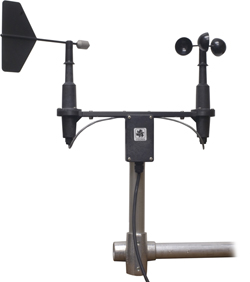The 03002 Wind Sentry Set consists of a 3-cup anemometer and a wind vane mounted on a small crossarm. The small size, simplicity, and rugged construction provide a quality instrument for a modest price. The sensor interfaces directly with Campbell dataloggers; no signal conditioning is required.
Rotation of the Wind Sentry's cup wheel produces an ac sine wave that is directly proportional to wind speed. The frequency of the ac signal is measured by a datalogger pulse count channel, then converted to engineering units (mph, m/s, knots). The Campbell Scientific version uses shielded bearings, which lower the anemometer's threshold.
Wind direction is sensed by a potentiometer. With the precision excitation voltage from the datalogger applied to the potentiometer element, the output signal is an analog voltage that is directly proportional to azimuth of the wind direction.

Features
3-cup anemometer and wind vane mounted on a common crossarm
Rugged design; CSI version uses shielded rather than sealed bearings (lowers threshold)
Specifications
Wind Speed (Anemometer)
Range: 0 to 50 m/s (112 mph)
Gust Survival: 60 m/s (134 mph)
Sensor: 12-cm diameter cup wheel assembly, 40-mm diameter hemispherical cups
Accuracy: ±0.5 m/s (1.1 mph)
Turning Factor: 75 cm (2.5 ft )
Distance Constant (63% recovery): 2.3 m (7.5 ft)
Threshold: 0.5 m/s (1.1 mph)
Transducer: Stationary coil; 1300 ohm nominal resistance
Transducer Output: AC sine-wave signal induced by rotating magnet on cup wheel shaft 100 mV peak-to-peak at 60 rpm; 6 V peak-to-peak at 3600 rpm
Output Frequency: 1 cycle per cup wheel revolution; 0.75 m/s per Hz
Wind Direction (Vane)
Range: 360° mechanical; 352° electrical (8° open)
Sensor: Balanced vane; 16 cm turning radius
Accuracy: ±5°
Damping Ratio: 0.2
Delay Distance (50% recovery): 0.5 m (1.6 ft )
Threshold
10° Displacement: 0.8 m s-1 (1.8 mph)
5° Displacement: 1.8 m/s (4 mph)
Transducer: Precision conductive plastic potentiometer; 10 kohm resistance; 1.0% linearity; life expectancy of 50 million revolutions. Rated 1 Watt at 40°C, 0 Watts at 125°C.
Transducer Excitation: Requires regulated dc voltage, 15 Vdc maximum
Transducer Output: Analog dc voltage proportional to wind direction angle with regulated excitation voltage supplied by the datalogger
Producing Area:USA